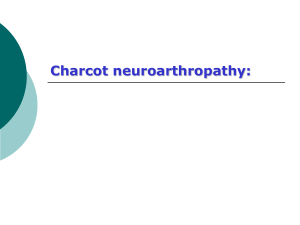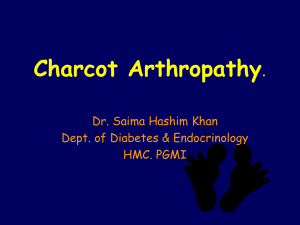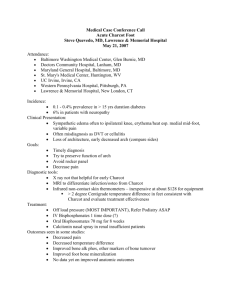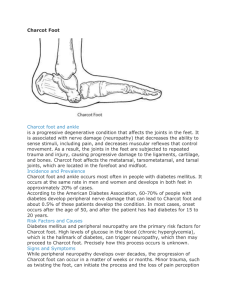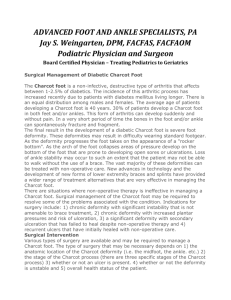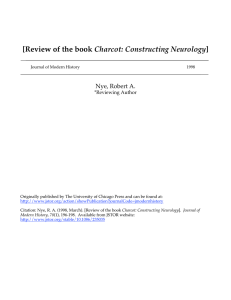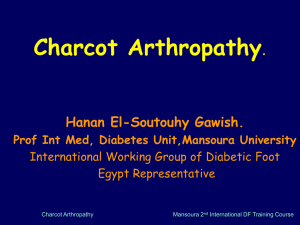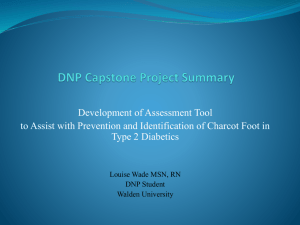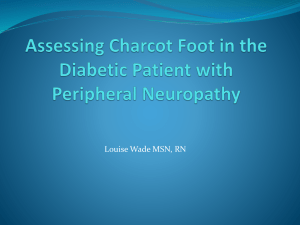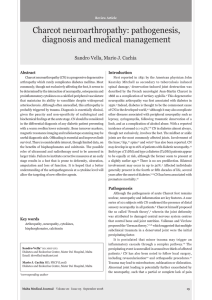Charcot`s Arthropathy
advertisement
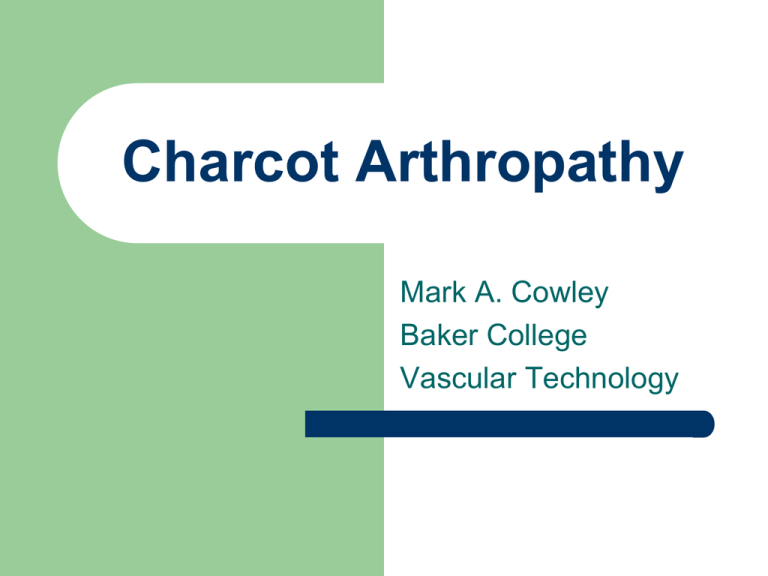
Charcot Arthropathy Mark A. Cowley Baker College Vascular Technology OVERVIEW What is Charcot Arthropahy. Etiology and Pathophysiology. Imaging and Diagnostic procedures. Presentation. Treatments. Recent Research. Quick Review. Charcot Arthropathy 1703 William Musgrave described a neuropathic joint as an athralgia. 1868 Jean-Martin Charcot gave the first detailed description of this disease. Charcot Arthropathy is a progressive condition of the musculoskeletal system that is characterized by joint dislocations, pathologic fractures, and debilitating deformities most commonly in the lower ext. Etiology Any condition that causes sensory or autonomic neuropathy Chronic alcoholism, renal dialysis, syphillis, leprosy, complication of diabetes. Before 1936 the leading cause of Charcot was thought to be syphillis, today the disease is most commonly found to be secondary to diabetes. Pathophysiology Major theories – Neurotraumatic theory – Neurovascular theory – Most probably both Imaging and Diagnostic Lab- WBC w/diff, erythrocyte sedimentation rate (ESR), Chem 7. Imaging- Radiographs, bone scan, MRI, ultrasound. Other- Bone probe, lumbar puncture, synovial biopsy. Presentation Mild swelling w/o deformity-Moderate deformity with extreme swelling. Signs of inflammation. Profound unilateral swelling. Increase in localized temp(5-10Degrees). Erythema, joint effusion. 75% pt. have pain. 40% lesions. Classification Brodsky and Rouse Type 1 Midfoot Type 2 Hindfoot Type 3a Ankle 3b Calcis tubercle Affected joints Radiographs Charcot Arthropathy Treatment Primarily nonoperative. Consists of Acute and Postacute phases. – – – – Acute Casting along with crutches and walkers. Postacute Include bracing, ankle-foot orthotics(AFO), specialized shoes. Treatment Casting- changed every 1-2weeks, if ulcerations are present changed every week for wound care, duration from 3-6 months. Shoes, bracing, and orthotics- duration from 6-24 months. Typical total healing time 1-2 years. Surgical Therapy Depend and vary on the disease process Plate and screw fixation Bone grafting Fixations Amputations Recent Studies Sohn group: Compared the risk of lower extremity amputations in patients with Charcot arthropathy alone and those with diabetic foot ulcers. Found that patients with Charcot arthropathy alone risk was 7 times greater than patients with ulceration only. Risk for patients with both increases 12 times. Recent Studies Della Paola group: Alternative to amputation, use of surgical treatment of osteomyelitis and external fixation. 45 pt.= 39 healed using surgery to drain an acute infection and maintaining fixation for an average of 26 weeks. 4pt. Infection could not be controlled, 2 pt. additional nails for fixation. Quick Review Charcot Arthropathy is a progressive condition of the musculoskeletal system characterized by joint degeneration and malformities. Secondary to conditions that cause sensory or autonomic neuropathy most commonly diabetes. Presents as swelling, loaclized temp. increase, Varied Treatments include NWB, orthotics, and surgical treaments, including amputation. References Caputo GM, Ulbrecht J, Cavanagh PR. The Charcot foot in diabetes: six key points. Am Fam Physician. Jun 1998;57(11):2705-10. [Medline]. Dalla Paola L, Brocco E, Ceccacci T, Ninkovic S, Sorgentone S, Marinescu MG, et al. Limb salvage in Charcot foot and ankle osteomyelitis: combined use single stage/double stage of arthrodesis and external fixation. Foot Ankle Int. Nov 2009;30(11):1065-70. [Medline]. References Frykberg RG, Zgonis T, Armstrong DG, et al. Diabetic foot disorders. A clinical practice guideline (2006 revision). J Foot Ankle Surg. Sep-Oct 2006;45(5 Suppl):S1-66. [Medline]. Sohn MW, Stuck RM, Pinzur M, Lee TA, Budiman-Mak E. Lower-extremity amputation risk after charcot arthropathy and diabetic foot ulcer. Diabetes Care. Jan 2010;33(1):98-100. [Medline].
